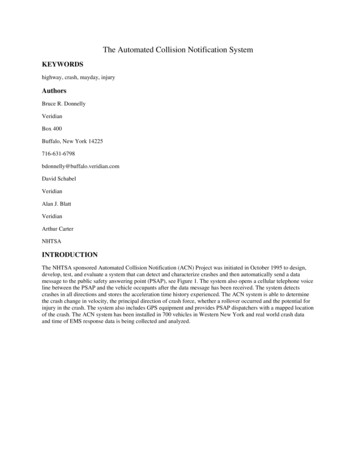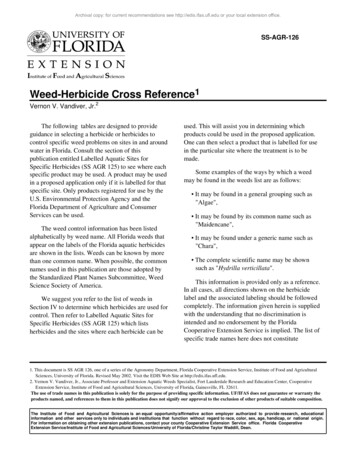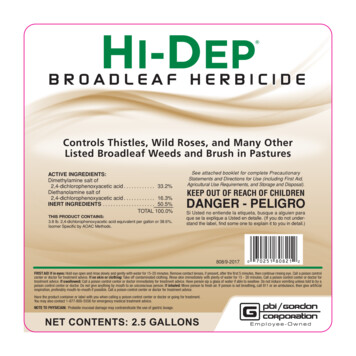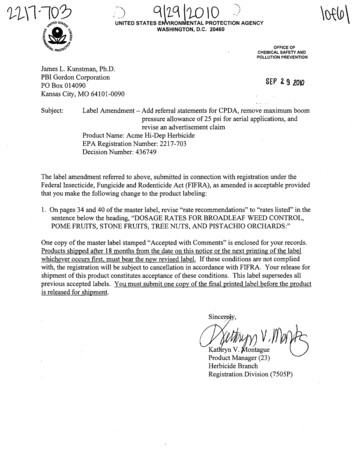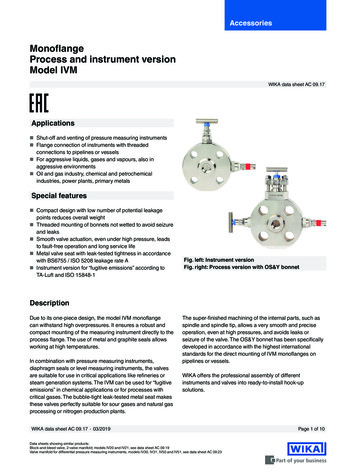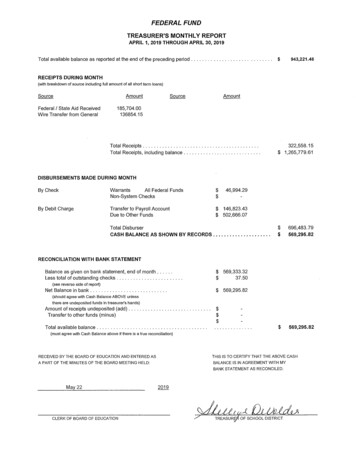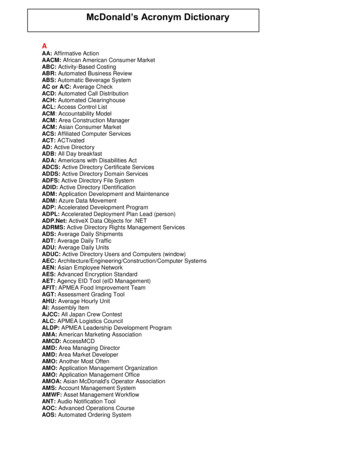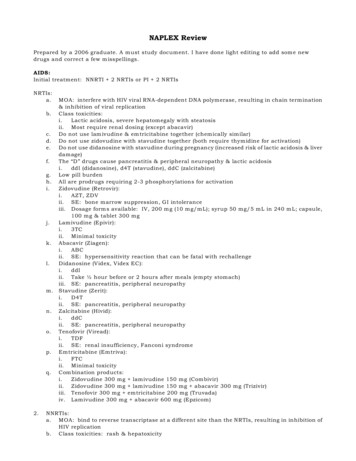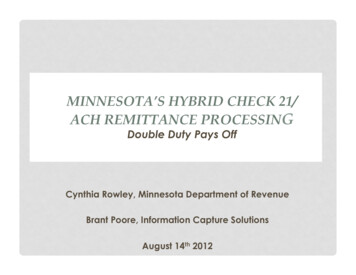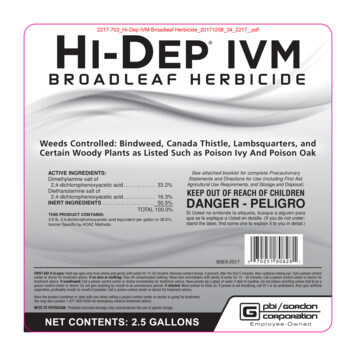
Transcription
Hi-Dep IVM (808) 2.5-G Front Label (9-2017).pdf19/5/1712:38 PMHI-DEP IVM2217-703 Hi-Dep IVM Broadleaf Herbicide 20171208 34 2217 .pdf Weeds Controlled: Bindweed, Canada Thistle, Lambsquarters, andCertain Woody Plants as Listed Such as Poison Ivy And Poison OakACTIVE INGREDIENTS:Dimethylamine salt of2,4-dichlorophenoxyacetic acid . . . . . . . . . . . . 33.2%Diethanolamine salt of2,4-dichlorophenoxyacetic acid . . . . . . . . . . . . 16.3%INERT INGREDIENTS . . . . . . . . . . . . . . . . . . . . 50.5%TOTAL 100.0%THIS PRODUCT CONTAINS:3.8 lb. 2,4-dichlorophenoxyacetic acid equivalent per gallon or 38.6%.Isomer Specific by AOAC Methods.See attached booklet for complete PrecautionaryStatements and Directions for Use (including First Aid,Agricultural Use Requirements, and Storage and Disposal).KEEP OUT OF REACH OF CHILDRENDANGER - PELIGROSi Usted no entiende la etiqueta, busque a alguien paraque se la explique a Usted en detalle. (If you do not understand the label, find some one to explain it to you in detail.)808/9-2017FIRST AID If in eyes: Hold eye open and rinse slowly and gently with water for 15-20 minutes. Remove contact lenses, if present, after the first 5 minutes, then continue rinsing eye. Call a poison controlcenter or doctor for treatment advice. If on skin or clothing: Take off contaminated clothing. Rinse skin immediately with plenty of water for 15 - 20 minutes. Call a poison control center or doctor fortreatment advice. If swallowed: Call a poison control center or doctor immediately for treatment advice. Have person sip a glass of water if able to swallow. Do not induce vomiting unless told to by apoison control center or doctor. Do not give anything by mouth to an unconscious person. If inhaled: Move person to fresh air. If person is not breathing, call 911 or an ambulance, then give artificialrespiration, preferably mouth-to-mouth if possible. Call a poison control center or doctor for treatment advice.Have the product container or label with you when calling a poison control center or doctor or going for treatment.You may also contact 1-877-800-5556 for emergency medical treatment advice.NOTE TO PHYSICIAN: Probable mucosal damage may contraindicate the use of gastric lavage.NET CONTENTS: 2.5 GALLONS6.5 x 6.5 InchesBLACK
18018 - Hi-Dep IVM (808) Universal ETL (9-2017).qxp 9/19/17 12:38 PM Page 14.75 x 5.25 inchesBLACK
18018 - Hi-Dep IVM (808) Universal ETL (9-2017).qxp 9/19/17 12:38 PM Page 2Weeds Controlled: Bindweed, Canada Thistle,Lambsquarters, and Certain Woody Plants as ListedSuch as Poison Ivy And Poison OakACTIVE INGREDIENTS:Dimethylamine salt of2,4-dichlorophenoxyacetic acid. . . . . . . . . . . . . . . . . . . . . . . . . . . . . . . . . . . . . . 33.2%Diethanolamine salt of2,4-dichlorophenoxyacetic acid. . . . . . . . . . . . . . . . . . . . . . . . . . . . . . . . . . . . . . 16.3%INERT INGREDIENTS . . . . . . . . . . . . . . . . . . . . . . . . . . . . . . . . . . . . . . . . . . . . . 50.5%TOTAL 100.0%THIS PRODUCT CONTAINS:3.8 lb. 2,4-dichlorophenoxyacetic acid equivalent per gallon or 38.6%.Isomer Specific by AOAC MethodsKEEP OUT OF REACH OF CHILDRENDANGER - PELIGROSi Usted no entiende la etiqueta, busque a alguien para que se la explique a Usted endetalle. (If you do not understand the label, find some one to explain it to you in detail.)KEEP FROM FREEZING–2–
18018 - Hi-Dep IVM (808) Universal ETL (9-2017).qxp 9/19/17 12:38 PM Page 3READ THE ENTIRE LABEL FIRST.OBSERVE ALL PRECAUTIONS ANDFOLLOW DIRECTIONS CAREFULLY.PRECAUTIONARY STATEMENTSHazards To Humans And Domestic AnimalsDANGER: Corrosive. Causes irreversible eye damage. Harmful if swallowed. Harmfulif absorbed through skin. Harmful if inhaled. Do not get in eyes or on clothing. Avoidcontact with skin. Avoid breathing spray mist or vapor.Personal Protective Equipment (PPE)Some materials that are chemical-resistant to this product are natural rubber, naturalrubber blends and laminates. If you want more options, follow the instructions forcategory A on an EPA chemical-resistance category selection chart.All mixers, loaders, applicators, flaggers, and other handlers must wear: protective eyewear, long-sleeved shirt and long pants, shoes and socks, chemical-resistant gloves when applying with any handheld nozzle or equipment,mixing or loading, cleaning up spills or equipment, or otherwise exposed to theconcentrate. chemical-resistant apron when mixing or loading, cleaning up spills or equipment, orotherwise exposed to the concentrate.See engineering controls for additional requirements.User Safety RequirementsFollow manufacturer’s instructions for cleaning/maintaining PPE. If no such instructions for washables exist, use detergent and hot water. Keep and wash PPE separatelyfrom other laundry.Engineering Control StatementsEngineering Controls for aerial application: When handlers use enclosed cabs oraircraft in a manner that meets the requirements listed in the Worker ProtectionStandard (WPS) for agricultural pesticides [40 CFR 170.240(d)(4-6)], the handler PPErequirements may be reduced or modified as specified in the WPS. Pilots must use anenclosed cockpit that meets the requirements listed in the WPS for agriculturalpesticides [40 CFR 170.240(d)(6)].–3–
18018 - Hi-Dep IVM (808) Universal ETL (9-2017).qxp 9/19/17 12:38 PM Page 4User Safety Recommendations Users should wash hands before eating, drinking, chewing gum, using tobacco, orusing the toilet. Users should remove clothing/PPE immediately if pesticide gets inside. Then washthoroughly and put on clean clothing. If pesticide gets on skin, wash immediatelywith soap and water. Users should remove PPE immediately after handling this product. Wash theoutside of gloves before removing. As soon as possible, wash thoroughly andchange into clean clothing.First AidIf in eyes: Hold eye open and rinse slowly and gently with water for 15-20minutes. Remove contact lenses, if present, after the first5 minutes, then continue rinsing eye. Call a poison control center or doctor for treatment advice.If on skinor clothing: Take off contaminated clothing. Rinse skin immediately with plenty of water for 15-20 minutes. Call a poison control center or doctor for treatment advice.If swallowed: Call a poison control center or doctor immediately for treatmentadvice. Have person sip a glass of water if able to swallow. Do not induce vomiting unless told to by a poison control centeror doctor. Do not give anything by mouth to an unconscious person.If inhaled: Move person to fresh air. If person is not breathing, call 911 or an ambulance, then giveartificial respiration, preferably mouth-to-mouth if possible. Call a poison control center or doctor for treatment advice.Have the product container or label with you when calling a poison control center ordoctor or going for treatment. You may also contact 1-877-800-5556 for emergencymedical treatment advice.NOTE TO PHYSICIAN: Probable mucosal damage may contraindicate the use ofgastric lavage.–4–
18018 - Hi-Dep IVM (808) Universal ETL (9-2017).qxp 9/19/17 12:38 PM Page 5Environmental HazardsThis pesticide is toxic to fish and aquatic invertebrates. Do not apply directly to water,to areas where surface water is present, or to intertidal areas below the mean highwater mark. Drift and runoff may be hazardous to aquatic organisms in water adjacentto treated areas. Do not contaminate water when disposing of equipment wash watersor rinsate.This chemical has properties and characteristics associated with chemicals detected ingroundwater. The use of this chemical in areas where soils are permeable, particularlywhere the water table is shallow, may result in groundwater contamination. Applicationaround a cistern or well may result in contamination of drinking water or groundwater.DIRECTIONS FOR USEIt is a violation of Federal law to use this product in a manner inconsistent with itslabeling.Do not apply this product in a way that will contact workers or other persons, eitherdirectly or through drift. Only protected handlers may be in the area during application.For any requirements specific to your State or Tribe, consult the agency responsible forpesticide regulation.Agricultural Use RequirementsUse this product only in accordance with its labeling and with the Worker ProtectionStandard, 40 CFR part 170.This standard contains requirements for the protection of agricultural workers onfarms, forests, nurseries, and greenhouses, and handlers of agricultural pesticides.It contains requirements for training, decontamination, notification, and emergencyassistance. It also contains specific instructions and exceptions pertaining to thestatements on this label about personal protective equipment and restricted-entryinterval. The requirements in this box only apply to uses of this product that arecovered by the Worker Protection Standard. Do not enter or allow worker entry intotreated areas during the restricted-entry interval (REI) of 48 hours.PPE required for early entry to treated areas that is permitted under the WorkerProtection Standard and that involves contact with anything that has been treated,such as plants, soil, or water is: coveralls, chemical-resistant gloves made of any water-proof material, shoes plus socks and protective eyewear.–5–
18018 - Hi-Dep IVM (808) Universal ETL (9-2017).qxp 9/19/17 12:38 PM Page 6Non-Agricultural Use RequirementsThe requirements in this box apply to uses of this product that are NOT within thescope of the Worker Protection Standard for agricultural pesticides (40 CFR Part170). The WPS applies when this product is used to produce agricultural plants onfarms, forests, nurseries, or greenhouses.Reentry Statement: Do not enter or allow people (or pets) to enter the treated areauntil sprays have dried.1. USE INSTRUCTIONSHi-Dep IVM Broadleaf Herbicide consists of the dimethylamine and diethanolaminesalts of 2,4-D especially formulated for low volume applications with aerial and groundequipment. For all methods of application, apply the spray solution in properly maintained and calibrated equipment capable of delivering the desired spray volumes.Follow the spray equipment manufacturer’s directions for cleaning, adjusting pressure,and selecting appropriate nozzles. This product must be applied in compliance withthe pesticide regulations of the state in which application in made. Check with localauthorities regarding regulations which may affect the application of this product. Usea minimum spray volume of 2.0 gallons per acre for ground and aerial applications.AIRCRAFT SPECIFICATIONS (FIXED WING OR ROTARY WING): Number ofnozzles required to obtain desired volume per acre is dependent on swath width andspeed of aircraft. Nozzles should be positioned between 135 and 175 from directionof flight for fixed wing. DO NOT APPLY THROUGH BECO-MIST NOZZLE SYSTEMS.See manufacturer’s technical bulletin regarding nozzles and application specifications.GROUND APPLICATION: Use conventional power spray equipment fitted with aboom, off-center nozzles, or spray gun for broadcast and spot treatments with highvolume and low volume foliar applications. Spray equipment may range from anengine driven pump system (e.g. tractor, truck, trailer, all terrain vehicle ATV, wet-blademowers) to self propelled sprayers. Backpack sprayers, knapsack sprayers, compression sprayers, and hand operated sprayers are appropriate for foliar applications andlow volume directed spray applications (basal bark, stem applications).PRECAUTION FOR PAINTS AND COATINGS OF AUTOMOBILES AND OTHERVEHICLES: Undiluted spray droplets may damage the paint, coating, or finish ofvehicles. Vehicles should not be sprayed. If accidental exposure does occur, then thevehicle should be washed before the spray droplets dry.–6–
18018 - Hi-Dep IVM (808) Universal ETL (9-2017).qxp 9/19/17 12:38 PM Page 7WEEDS CONTROLLEDArtichokeAsterAustrian fieldcressBindweedBlackeyed susanBlue lettuceCanada thistleCatnipChicoryClover (many terweedBlack medicBroomweedBull thistleBurdockCarpetweedCatchweed vilsclawFalseflaxFleabane (daisy)FlixweedFrenchweedPERENNIAL WEEDSDogfennelGoldenrodGround ivyHealallHemlockIronweedKnapweed (spottedRussian, diffuse)Leafy spurgeLocoweedMugwortNettlesOrange hawkweedPovertyweedRush, slenderSowthistleSt. JohnswortStinging nettleStrawberry (wild)Tall buttercupTanweedToadflaxVervainWhitetop (hoary cress)Wild garlicWild onionWild sweet potatoYellow rocketANNUAL AND BIENNIAL WEEDSGalinsogaMiners lettuceGoatsbeardMorningglory (annual)GoosefootMusk essJewelweedPepperweedJimsonweedPigweed (redroot)Jim Hill mustardPlantain(Tumble mustard)Prickly ttuce (wild)Radish (wild)MallowRagweedMarestail (horseweed)Russian thistleMarijuanaScotch thistleMarshelderShepherd’s purse(cont. on next page)Mediterranean sage–7–
18018 - Hi-Dep IVM (808) Universal ETL (9-2017).qxp 9/19/17 12:38 PM Page 8SneezeweedSowthistle (common)Spanish needlesSunflowerTansy mustardTansy ragwortANNUAL AND BIENNIAL WEEDS (cont.)TumbleweedWild turnipTumble pigweedWitchweedVelvetleafWormwoodVetchYellow starthistleWild carrotWild parsnipALSO CERTAIN 2,4-D SUSCEPTIBLE WOODY PLANTS:Big sagebrushHazelPoison oakBuckbrushLocustRabbitbrushCedarMacartney roseSagebrushChamiseManzanitaShinnery oakCherokee roseMultiflora roseSumacCoastal sagePineTropical soda appleElderberryPoison ivyWillow2. SPRAY DRIFT MANAGEMENTA variety of factors including weather conditions (e.g., wind direction, wind speed,temperature, relative humidity) and method of application (e.g., ground, aerial, airblast,chemigation) can influence pesticide drift. The applicator must evaluate all factors andmake appropriate adjustments when applying this product.Droplet Size. When applying sprays that contain 2,4-D as the sole active ingredient,or when applying sprays that contain 2,4-D mixed with active ingredients that require aCoarse or coarser spray, apply only as a Coarse or coarser spray (ASAE standard572) or a volume mean diameter of 385 microns or greater for spinning atomizernozzles. When applying sprays that contain 2,4-D mixed with other active ingredientsthat require a Medium or more fine spray, apply only as a Medium or coarser spray(ASAE standard 572) or a volume mean diameter of 300 microns or greater forspinning atomizer nozzles.Wind Speed. Do not apply at wind speeds greater than 15 mph. Only apply thisproduct if the wind direction favors on-target deposition and there are not sensitiveareas (including, but not limited to, bodies of water, known habitat for nontargetspecies, nontarget crops) within 250 feet downwind. If applying a Medium spray, leaveone swath unsprayed at the downwind edge of the treated field.–8–
18018 - Hi-Dep IVM (808) Universal ETL (9-2017).qxp 9/19/17 12:38 PM Page 9Temperature Inversions. If applying at wind speeds less than 3 mph, the applicatormust determine if: a) conditions of temperature inversion exist, or b) stableatmospheric conditions exist at of below nozzle height. Do not make applications intoareas of temperature inversions or stable atmospheric conditions.Susceptible Plants. Do not apply under circumstances where spray drift may occur tofood, forage, or other plantings that might be damaged or crops thereof rendered unfitfor sale, use or consumption. Susceptible crops include, but are not limited to, cotton,okra, flowers, grapes (in growing stage), fruit trees (foliage), soybeans (vegetativestage), ornamentals, sunflowers, tomatoes, beans, and other vegetables, or tobacco.Small amounts of spray drift that might not be visible may injure susceptible broadleafplants.Other State and Local Requirements. Applicators must follow all state and localpesticide drift requirements regarding application of 2,4-D herbicides. Where stateshave more stringent regulations, they must be observed.Equipment. All aerial and ground application equipment must be properly maintainedand calibrated using appropriate carriers or surrogates.Additional requirements for ground boom application. Do not apply with a nozzleheight greater than 4 feet above the crop canopy.Additional requirements for aerial applications. The boom length must not exceed75% of the wingspan or 90% of the rotor blade diameter. Release spray at the lowestheight consistent with efficacy and flight safety. Do not release spray at a heightgreater than 10 feet above the crop canopy unless a greater height is required foraircraft safety. This requirement does not apply to forestry or rights-of-way applications. When applications are made with a crosswind, the swath will be displaced downwind. The applicator must compensate for this by adjusting the path of the aircraftupwind.3. NONCROPLANDNoncropland including fencerows, hedgerows, roadsides, drainage ditchbanks, firebreaks, highway rights-of-way, utility rights-of-way, airports/airfields, vacant lots andindustrial sites. Applications to non-cropland areas are not applicable to treatment ofcommercial timber or other plants being grown for sale or other commercial use, or forcommercial seed production, or for research purposes.Broadcast applications to woody plants: Apply to trees and brush when foliage isfully expanded and plants are actively growing. Up to 1.0 gallon of product per acre–9–
18018 - Hi-Dep IVM (808) Universal ETL (9-2017).qxp 9/19/17 12:38 PM Page 10(4.0 lbs. acid equivalent per acre) may be applied in a single application. Themaximum noncropland application rate for tree, brush and woody plant control is 1.0gallon of product per acre per application per site.TargetspeciesApplicationscheduleMaximum Rateper ApplicationWoodyplantsBroadcastand highvolume foliar1.0 gal./A or 8 pints/A(4.0 lb. 2,4-D ae/A)MaximumNumber ofApplicationsper yearMinimum Intervalbetween applications1N/AHigh volume foliar applications (100 to 400 gallons per acre): Apply 0.25 to 1.0gallon of product per acre with adequate water or apply a 0.25 to 1.0% vol/vol spraysolution as a full cover spray with high volume equipment. Use the lower sprayconcentrations in the range for susceptible species and use the higher spray concentrations within the range for hard-to-control species, for mature plants during the latesummer or under adverse environmental conditions (e.g. drought). The maximumseasonal application rate for trees, brush and woody plant control is 1.0 gallon ofproduct per acre per application per siteSpray broadleaf weeds, woody plants or mixed brush uniformly and thoroughly bywetting all leaves, stems, bark and root collars. The total volume of spray solutionrequired for adequate coverage of solid stands of mixed brush can range from 100 to400 gallons of spray solution per treated acre. The spray preparation chart for applications on a spray-to-wet basis is shown below.Woody Plants: Instructions for preparing 100 to 400 gallons of spray solution at 0.25 to 1.0%spray concentration with water for high volume foliar applications.Amount of Product Needed for Spray Concentration of:Spray solution0.25%0.33%0.5%1.0%0.25 gal.0.33 gal.0.5 gal.1.0 gal.200 gal/.A0.5 gal.0.67 gal.1.0 gal.—300 gal./A0.75 gal.1.0 gal.——400 gal./A1.0 gal.———100 gal./AEqual measures: 1gallon 4 quarts 8 pints 128 fl. oz.– 10 –
18018 - Hi-Dep IVM (808) Universal ETL (9-2017).qxp 9/19/17 12:38 PM Page 11For Backpack sprayers, knapsack sprayers, and hand-pressurized pump sprayersWoody Plants: Instructions for preparing 1 to 3 gallons of spray solution at 0.25 to 1.0% sprayconcentration with water for high volume foliar applications.Amount Of Product Needed for Spray Concentration of:GallonsOf Water0.25%0.33%0.5%1.0%12 teaspoons3 teaspoons4 teaspoons8 teaspoons24 teaspoons2 tablespoons3 tablespoons6 tablespoons32 tablespoons3 tablespoons4 tablespoons8 tablespoonsEqual measures: 1 fl. oz. 2 Tablespoons (Tbs.) 6 Teaspoons (tsp.)Dosage rate per acre depends on the density of brush and/or weeds. For smallbroadleaf weeds, use the lower rate. Heavy dense stands of brush require the highrate with higher water volume. To effectively control brush, all leaves, stems andsuckers should be thoroughly wetted to the ground. Apply when plants come into fullleaf (spring) to the time plants begin to go dormant. Best results are obtained whenbrush and broadleaf weeds are young and actively growing. Do not cut brush until theherbicide has translocated throughout the plant causing root death.Broadcast applications to annual and perennial weeds in noncropland: Airfields,Roadsides, Vacant Lots and Drainage Ditchbanks. Apply to emerged weeds. For bestresults, treat when weeds are young and actively growing. Use 1.0 to 2.0 quarts ofproduct per acre. The maximum application rate to noncropland sites is 2.0 quarts(4 pints) of product per acre per application per site. Minimum spray volume: Use2 or more gallons of spray solution per acre. Number of applications: Limited to2 applications per year.MaximumMinimumNumber ofIntervalMinimumApplications betweenSpray Recommendedper year applications Volume Spray VolumeTargetspeciesApplicationscheduleMaximum Rateper ApplicationAnnual andperennialweedsBroadcast2.0 quarts/A or 4 pints/A(2.0 lb. 2,4-D ae/A)– 11 –230 Days2 gal./A2 to 10 gal./A
18018 - Hi-Dep IVM (808) Universal ETL (9-2017).qxp 9/19/17 12:38 PM Page 12Utility and Pipeline Rights-of-Way — For woody plants: Use up to 1/2 to 1 gallon peracre of Hi-Dep IVM Broadleaf Herbicide in tank mix combination with other herbicideslabeled for rights-of-way and with spray volumes greater than 2 gallons per acre.TANK MIXTURES FOR INDUSTRIAL/NONCROPLAND AREAS: Hi-Dep IVMBroadleaf Herbicide, a mixed amine salt of 2,4-D, can be applied as a tank mixturewith other recommended herbicides such as Garlon , Escort , Tordon , Banvel ,Vanquish , and Accord to broaden the spectrum of control. In order to assuremaximum safety and weed control, follow all precautions and limitations on this labeland the labels of products used in tank mixtures with Hi-Dep IVM Broadleaf Herbicide.Backpack - Use 3 to 5% solution of Hi-Dep IVM Broadleaf Herbicide in tank mixcombinations with other herbicides labeled for rights-of-way sites and apply in a totalspray volume of 5 to 20 gallons per acre.TREE INJECTION:To control unwanted hardwood trees make injections as near the root collar aspossible using one injection per inch of trunk’s diameter at breast height. For resistantspecies such as hickory, injections should overlap. For best results injections shouldbe made during the growing season, May 15 to October 1. Use only one injectionapplication per year.For Concentrate Injection: Use 1 to 2 ml. of concentrate per injection site. Theinjector bit must penetrate the inner bark.LEAFY SPURGE CONTROL IN COLORADO, IDAHO, MINNESOTA, MONTANA,NEBRASKA, NORTH DAKOTA, SOUTH DAKOTA, WASHINGTON AND WYOMING:Hi-Dep IVM Broadleaf Herbicide is recommended for use in combination with Tordon or Banvel for the suppression and/or control of leafy spurge on industrial noncroplandsites in Colorado, Idaho, Minnesota, Montana, Nebraska, North Dakota, South Dakota,Washington and Wyoming.HOW TO USE:Apply 1 to 2 quarts of Hi-Dep IVM Broadleaf Herbicide in combination with 1 quart ofTordon , or 2 quarts of Hi-Dep IVM Broadleaf Herbicide plus 2 quarts of Banvel , or2 quarts of Hi-Dep IVM Broadleaf Herbicide plus 1 pint of Tordon plus 1 quart ofBanvel . Rates are on a per acre basis.Mix with water with spray volumes of 2 to 10 gallons per acre with conventional equipment. Add a nonionic agricultural surfactant at 0.25% by vol./vol. (e.g. 1 quart ofsurfactant per 100 gallons of solution).– 12 –
18018 - Hi-Dep IVM (808) Universal ETL (9-2017).qxp 9/19/17 12:38 PM Page 13IMPORTANT: Before using Hi-Dep IVM Broadleaf Herbicide, TORDON and/orBANVEL in these combinations, read and carefully observe the precautionary statements and all other information appearing on the product labels.Broadcast applications to annual and perennial weeds in noncropland:Airfields, Roadsides, Vacant Lots and Drainage Ditchbanks.Apply to emerged weeds. For best results, treat when weeds are young and activelygrowing. Use 1.0 to 2.0 quarts of product per acre. The maximum application rate tononcropland sites is 2.0 quarts (4 pints) of product per acre per application per site.Minimum spray volume: Use 2 or more gallons of spray solution per acre. Number ofapplications: Limited to 2 applications per year.TargetspeciesApplicationscheduleMaximum Rateper ApplicationAnnual andperennialweedsBroadcast2.0 quarts/Aor 4 pints/A(2.0 lb. 2,4-D ae/A)MaximumMinimumNumber ofIntervalApplicationsbetweenMinimumper yearapplications Spray Volume230 Days2 gal./ASpot treatments for annual and perennial weedsBackpack sprayers, knapsack sprayers, and hand-pressurized pump sprayers:Instructions for preparing 1 to 3 gallons of spray solution at 0.25 to 1.0% spray concentrationwith water for high volume foliar applications.Gallonsof WaterApprox.treated area1800 sq. ft.Amount Of Product Needed for Spray Concentration of:0.25%0.33%0.5%1.0%2 teaspoons3 teaspoons4 teaspoons8 teaspoons21600 sq. ft.4 teaspoons2 tablespoons3 tablespoons6 tablespoons32400 sq. ft.2 tablespoons3 tablespoons4 tablespoons8 tablespoonsEqual measures: 1 fl. oz. 2 Tablespoons (Tbs.) 6 Teaspoons (tsp.)– 13 –
18018 - Hi-Dep IVM (808) Universal ETL (9-2017).qxp 9/19/17 12:38 PM Page 14Broadcast applications to annual and perennial weeds: Apply to emerged weeds.For best results, treat when weeds are young and actively growing. Use 1.0 to 2.0quarts of product per acre. Minimum spray volume: Use 2 or more gallons of spraysolution per acre. Number of applications: Limited to 2 applications per year.TargetspeciesApplicationscheduleMaximum Rateper ApplicationAnnual andperennialweedsBroadcast2.0 quarts/Aor 4 pints/A(2.0 lb. 2,4-D ae/A)MaximumNumber ofApplicationsper yearMinimumIntervalbetweenapplicationsMinimumSpray Volume230 Days2 gal./AHerbicide combinations offer advantages including improved weed control, reducedcost, and greater selectivity. Generally herbicide combinations with Hi-Dep IVMBroadleaf Herbicide provide an additive response, and the minimum dosage raterecommended for Hi-Dep IVM Broadleaf Herbicide in tank mixtures is 1.0 pint ofproduct (0.25 pounds acid equivalent per acre).4. ORNAMENTAL TURFGRASSBroadcast applications to annual and perennial weeds in Ornamental Turfgrass(Lawns, Golf Courses, Cemeteries, and Parks)Use 1.0 to 1.5 quarts of product per acre. The maximum application rate is 1.5 quartsof product per acre per application (1.5 lbs 2,4-D acid equivalent per acre per application). The maximum number of broadcast applications is limited to 2 per year. Themaximum seasonal rate is 3.0 quarts of product per acre (3.0 lbs 2,4-D acid equivalentper acre), excluding spot treatments.Do not use on dichondra or other herbaceous groundcovers. Do not use on creepinggrasses such as bentgrass except for spot treating nor on newly seeded turf untilgrass is well established. Reseeding of lawns should be delayed following treatment.With spring application, reseed in the fall; with fall application, reseed in the spring.Legumes are usually damaged or killed. Deep rooted perennial weeds such asbindweed and Canada thistle may require repeated applications.– 14 –
18018 - Hi-Dep IVM (808) Universal ETL (9-2017).qxp 9/19/17 12:38 PM Page 15STORAGE AND DISPOSALDo not contaminate water, food, or feed by storage or disposal.PESTICIDE STORAGE: Store in original container in a locked storage area inaccessible to children or pets. Keep from freezing.PESTICIDE DISPOSAL: Pesticide wastes are acutely hazardous. Improper disposalof excess pesticide, spray mixture, or rinsate is a violation of Federal law. If thesewastes cannot be disposed of by use according to label instructions, contact yourState Pesticide or Environmental Control Agency, or the Hazardous WasteRepresentative at the nearest EPA Regional Office for guidance.For Plastic Containers – Nonrefillable with capacities equal to or less than5 gallons:CONTAINER HANDLING: Nonrefillable container. Do not reuse or refill thiscontainer. Offer for recycling, if available, or puncture and dispose of in a sanitarylandfill, or by incineration, or, if allowed by state and local authorities, by burning. Ifburned, stay out of smoke.Triple rinse or pressure rinse container (or equivalent) promptly after emptying.Triple rinse as follows: Empty the remaining contents into application equipment or amix tank and drain for 10 seconds after the flow begins to drip. Fill the container 1/4full with water and recap. Shake for 10 seconds. Pour rinsate into application equipment or a mix tank or store rinsate for later use or disposal. Drain for 10 secondsafter the flow begins to drip. Repeat this procedure two more times.ORPressure rinse as follows: Empty the remaining contents into application equipmentor a mix tank and continue to drain for 10 seconds after the flow begins to drip. Holdcontainer upside down over application equipment or mix tank or collect rinsate forlater use or disposal. Insert pressure rinsing nozzle in the side of the container, andrinse at about 40 PSI for at least 30 seconds. Drain for 10 seconds after the flowbegins to drip.For Plastic Containers – Nonrefillable with capacities greater than 5 gallons:CONTAINER HANDLING: Nonrefillable container. Do not reuse or refill thiscontainer. Offer for recycling, if available, or puncture and dispose of in a sanitarylandfill, or by incineration, or, if allowed by state and local authorities, by burning. Ifburned, stay out of smoke.(cont. on next page)– 15 –
18018 - Hi-Dep IVM (808) Universal ETL (9-2017).qxp 9/19/17 12:38 PM Page 16STORAGE AND DISPOSAL (cont.)Triple rinse or pressure rinse container (or equivalent) promptly after emptying.Triple rinse as follows: Empty the rem
Hi-Dep IVM Broadleaf Herbicide consists of the dimethylamine and diethanolamine salts of 2,4-D especially formulated for low volume applications with aerial and ground equipment. For all methods of application, apply the spray solution in properly main - tained and calibrated e
